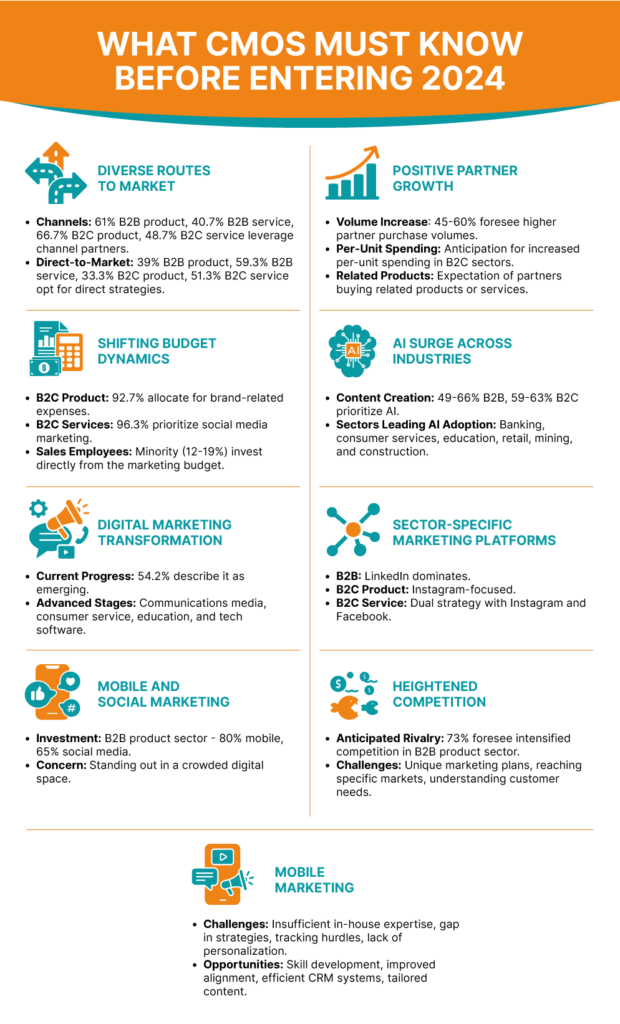![What CMOs Must Know in 2024 [Latest Marketing Stats]](https://www.codesm.com/wp-content/uploads/2023/11/codesm-nov-blog-1-banner.png)
As Chief Marketing Officers (CMOs) gear up for the upcoming year, several key marketing stats and trends are shaping the landscape of business-to-business (B2B) and business-to-consumer (B2C) sectors.

Understanding and adapting to these marketing stats and trends will be crucial for a successful marketing strategy. Here’s what you must expect before entering 2024:
Diverse Routes to Market
Marketing leaders should be ready for a changing environment as partnerships using different channels continue to be common. 61% of B2B product firms, 40.7% of B2B service providers, 66.7% of B2C product enterprises, and 48.7% of B2C service companies leverage channel partners.
76.9% of the consumer packaged goods sector, 68.2% of the healthcare sector, 79.3% of the manufacturing sector, 72.2% of the transportation sector, and 60% of the retail wholesale sector will use channel partners.
Meanwhile, 39% of B2B product businesses, 59.3% of B2B service entities, 33.3% of B2C product ventures, and 51.3% of B2C service organizations opt for direct-to-market strategies. 78.6% of the communications media sector, 71.4% of the consumer service sector, 68.8% of the energy sector, and 73.1 % of the professional service sector will go directly to market.
In 2024, working with channel partners can help you reach more markets and tap into diverse skills. But it also brings worries about perspectives not matching up, mixed branding, and less control over how customers experience the brand. If things go wrong, it might lead to clashes with partners, weakening the brand message, and trouble keeping everyone on the same page.
On the other hand, selling directly gives more control and a consistent brand.
Direct selling provides an opportunity open to absolutely everyone, regardless of background, specialized skills, or capital worth.
— Paul Zane Pilzer, American Economist and Social Entrepreneur
However, you could have to worry about not reaching enough people and dealing with more tasks. They need to find a middle ground, using both methods, building strong partnerships, and balancing things for steady growth.
Positive Partner Growth
A significant 45% to 60% of participants in both B2B and B2C sectors foresee an uptick in partner purchase volumes. In fact, all the participants from the communications media sector and the mining construction sector expect an increase in the partner’s purchase volume. Moreover, 70% of the healthcare sector and 75% of the tech software sector expect the same.
In the B2C realm, expectations rise for an increase in partner’s per-unit spending. All the participants from the consumer services sector and the mining construction sector expect an increase in the partner’s price per unit. Moreover, 68.4% of the consumer packaged goods sector, 60% of the healthcare sector, and 66.7% of the real estate sector expect the same.
Furthermore, most participants in both B2B and B2C sectors anticipate partners purchasing related products or services. In fact, all the participants from the communications media sector and the mining construction sector expect an increase in the possibility that the partner will buy related products or services from their company.
Moreover, 61.1% of the banking finance insurance sector, 70% of the healthcare sector, 80% of the pharma biotech sector, and 66.7% of the real estate sector expect the same.
While expecting more purchases from partners sounds good, you need to be careful about relying on them. If these partnerships don’t work out, there’s a risk of losing revenue. Mistakes in judging what the market wants can lead to making too much or having unused resources.
Still, CMOs may make more revenue per item sold, which can help profits and make customers more loyal to the brand. To avoid oversaturating the market and losing value, it’s important to set prices carefully.
Marketing Stats on Budget Dynamics
The B2C product sector overwhelmingly (92.7%) incorporates brand-related expenses into their marketing budget. Conversely, the B2C services sector prioritizes social media marketing, with a significant majority (96.3%) allocating funds to this channel.
B2C companies need a different approach to social media marketing.
Compared to B2B.
Market sophistication is different.
B2C is more about virality & nurturing.
— Kenneth Blanchette (@KenWritesTweets) November 5, 2023
Surprisingly, a minority in the B2B and B2C sectors (12% to 19%) invest in sales employees directly from their marketing budget. Focusing on brand-related costs in B2C product businesses can make the brand stronger, but CMOs might get concerned about spending too much on one aspect in 2024.
In B2C service businesses, giving importance to social media marketing can create better chances for interaction. But you may have to worry about changes in platform rules affecting how many people come across your brand.
Also, not investing enough in sales staff across different areas might mean missing out, but there’s a fear of not using resources wisely. you need to find a balance, using chances well while avoiding possible problems.
The AI Surge: Marketing Stats Across Industries
Notably, 49% to 66% of B2B product businesses leverage AI for content creation, while B2C service providers (59% to 63%) prioritize content personalization. CMOs can expect a surge in AI adoption, especially in banking, finance, insurance, energy, and manufacturing:
- The banking (62.1%) & consumer service (80%) sectors lead in AI-driven content personalization.
- Education (62.5%) and retail (78.9%) sectors leverage AI for real-time ad targeting.
- In mining and construction, AI optimizes content and timing for improved ROI.
- Consumer services (80%) dominate AI-driven marketing automation.
- Professional services (68.2%) use AI to excel in content creation.
AI offers chances to improve content creation, personalization, and real-time targeting, promising better returns on investment (ROI).
How to create anything with AI in 2 minutes: pic.twitter.com/lPsyRtwCe5
— Robin Delta (@heyrobinai) November 12, 2023
You can expect failures to happen because of not fully grasping or mishandling AI marketing tools, resulting in content that feels impersonal or lacks impact. Keeping up with rapid technological changes could also be a concern for them.
Strategic Digital Marketing Transformation Progress
To stay competitive in this digital marketing space, ensure that people keep interacting with you and what you do.
Improving online visibility and interaction enhances brand awareness, builds credibility and fosters connections with your audience.
The more you are visible, the…
— Janet Machuka (@janetmachuka_) November 13, 2023
54.2% of participants in the B2B and B2C sectors currently describe their digital marketing transformation progress as emerging, having developed non-integrated digital elements. In the imminent future, this marketing stat suggests a transition to full integration of digital investments across companies.
On the other hand, sectors like communications media, consumer service, education, and tech software showcase advanced stages, either fully integrating digital investments or leveraging them for data-driven marketing decisions.
You may deal with concerns about strategies not working together, communication issues, and not having the right skills for changes. But, they may find opportunities to improve how companies connect with customers, make decisions using data, and have an edge by fully embracing digital methods.
Sector-Specific Marketing Platforms
LinkedIn dominates the B2B realm, emerging as the linchpin for both product and service sectors. In contrast, B2C product players lean heavily on Instagram, while B2C service providers find value in a dual strategy, relying on Instagram and Facebook.
CMOs may have to worry about having too much content on popular platforms, making it harder to reach people naturally and thus facing more competition. They might experience problems if they can’t adjust their content strategy for different audiences on these platforms, leading to a disconnect and less effectiveness.
But, if they accept these trends, there’s a chance to target specific groups, make the brand more visible, and get more people interested. Teaming up with popular influencers on these platforms can help you reach even more people. They need to handle these changes by using the strengths of each platform and trying new ideas for a complete and successful marketing plan.
Mobile and Social Marketing Stats in B2B Sectors
In the B2B product sector, an impressive 80% investment in mobile activities and 65% in social media marketing reflects a growing emphasis on digital channels. But there’s a concern that too many businesses using these platforms might make it harder to stand out.
In the tech software industry, which spends 42% on these marketing activities, adapting content for different audiences could be tricky. However, using these preferences wisely can help target the right customers, make the brand more visible, and boost engagement.
Heightened Competition
CMOs should brace for more competition, notably in the finance, insurance, banking, consumer packaged goods, consumer services, healthcare, pharma biotech, and tech software sectors. In fact, a substantial 73% of B2B product sector participants anticipate intensified rivalry for customer attention.
You may worry about too many products in the market, losing loyal customers, and facing tough competition. But, there are chances for success from being creative, making smart partnerships, and focusing on campaigns that connect with certain groups of customers. They can use the competitive environment to encourage new ideas and flexibility.
Mobile Marketing Challenges
As CMOs gear up for the approaching year, they should anticipate key challenges in mobile marketing. Some of the challenges they might face in the near future are as follows:
- Insufficient in-house mobile expertise for B2B product success
- Lack of enough personalization in content delivery for B2C service
- The gap between mobile and broader marketing strategies for B2B service excellence
- Hurdles of tracking customers throughout their journey in the B2C product & service sectors
However, addressing these challenges presents the following opportunities for you:
- Development of more efficient and integrated customer relationship management systems.
- Skill development, potentially leading to a more robust team and improvement in strategic alignment.
- Tailoring content, fostering stronger connections with customers, and potentially increasing brand loyalty.
Frequently Asked Questions (FAQs)
What are the primary focuses for Chief Marketing Officers in 2024?
In 2024, CMOs are concentrating on increasing customer retention, enhancing pipeline analytics, improving marketing attribution, gaining real-time marketing insights, generating more qualified leads, and optimizing the integrated digital journey, as highlighted by the latest marketing stats.
What metrics should CMOs pay attention to?
Based on recent marketing stats, CMOs should prioritize metrics such as overall pipeline health, conversion rates to closed-won deals, net dollar retention, customer engagement levels, and annual recurring revenue to gauge marketing effectiveness.
What was the biggest marketing statistic in 2023?
Marketing stats revealed a major trend in 2023: the surge in influencer marketing, with over 82% of brand marketers allocating budgets to this area. The influencer marketing industry is anticipated to reach a value of $21.1 billion, marking a 29% year-over-year growth.
How can CMOs effectively manage marketing budgets in 2024 based on the latest marketing stats?
According to marketing stats, CMOs can manage budgets by prioritizing high-ROI activities, using data-driven strategies, and investing in cost-effective digital channels like social media and email marketing.
What are the strategies for measuring marketing ROI in 2024?
Marketing stats suggest that for measuring ROI, CMOs should integrate advanced analytics tools, focus on unified metrics that reflect business goals, and use AI-driven analytics for predictive insights.
How can partnerships enhance a brand’s marketing approach?
As indicated by marketing stats, partnerships can amplify marketing efforts, extend reach, and provide innovative campaign opportunities through shared resources and co-branded initiatives.
What mobile marketing tactics are effective in B2B sectors?
Marketing stats show that effective mobile marketing in B2B includes:
- Optimizing content for mobile devices.
- Using SMS and push notifications for engagement.
- Developing mobile apps for better customer interaction.
How can CMOs differentiate their brands in a competitive 2024 market?
Based on marketing stats, differentiation can be achieved through unique branding, high-quality content, personalized marketing, and the use of emerging technologies like AR/VR.
What are the challenges and solutions in mobile marketing as per the marketing stats?
Marketing stats indicate that challenges include maintaining user privacy, creating optimized content, and screen size limitations. Solutions involve respecting user data, focusing on impactful messaging, and ensuring responsive design.
Why is social media marketing crucial for B2B companies in 2024?
According to marketing stats, social media is key for B2B companies for brand awareness, customer engagement, lead generation, and networking, particularly on platforms like LinkedIn.
How can sector-specific marketing platforms benefit CMOs?
Marketing stats recommend that CMOs can benefit by tailoring their strategies to the unique audience needs on these platforms, addressing specific industry challenges, and leveraging industry-focused features for targeted marketing efforts.
The Bottomline
CMOs entering 2024 might face a dynamic landscape. Balancing diverse market routes, positive partner growth projections, and AI integration brings opportunities but demands cautious navigation.
Shifting budget dynamics, sector-specific platforms, mobile challenges, and increased competition lead to the need for strategic creativity. Addressing these marketing stats and trends with agility promises you success and better customer connections.
Here’s the ultimate solution to all your marketing challenges in 2024!





